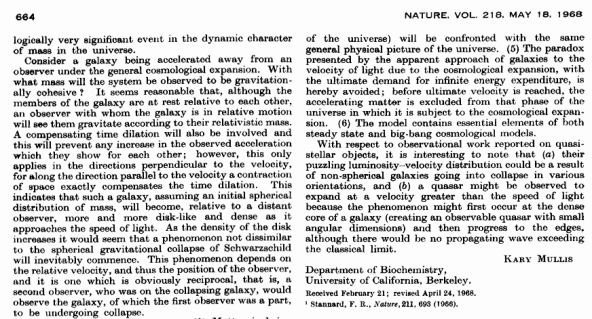 There are scientists who became big players in a particular discipline but before that they made also more or less successful efforts in an unrelated branch of science. For instance, Kary Mullis, inventor of the Polymerase Chain Reacion (PCR) wrote an early and pretty bizarre cosmological letter entitled Cosmological Significance of Time Reversal published in no other science journal, than Nature. Or there is Robert Lanza, regenerative medicine expert, who had psychological papers in his Harvard youth. Whatever is the value of those early and usually B contributions, they say us something on the nature of specialization in science. I suspect that sometimes multitalent is just by coincidence, but there could be cases, when there is a deeper relation behind the multifaceted energy. In art, multitalent is a well-known phenomenon, think about the drawings and paintings of Goethe, or the violin of Ingres.
There are scientists who became big players in a particular discipline but before that they made also more or less successful efforts in an unrelated branch of science. For instance, Kary Mullis, inventor of the Polymerase Chain Reacion (PCR) wrote an early and pretty bizarre cosmological letter entitled Cosmological Significance of Time Reversal published in no other science journal, than Nature. Or there is Robert Lanza, regenerative medicine expert, who had psychological papers in his Harvard youth. Whatever is the value of those early and usually B contributions, they say us something on the nature of specialization in science. I suspect that sometimes multitalent is just by coincidence, but there could be cases, when there is a deeper relation behind the multifaceted energy. In art, multitalent is a well-known phenomenon, think about the drawings and paintings of Goethe, or the violin of Ingres.
Help me collect other recent examples of surprising multitalent in the natural sciences.
Hey, don’t forget Kary Mullis’s other talents: using his Nobel prize to give credence to the ideas that HIV doesn’t cause AIDS and global warming is a hoax. My hero. 🙂
Yeah, thanks for those bits. I also heard rumors on the explicit content Mullis used to use during his presentations.
In these “eminent scientist behaving badly” days, this is a collection from Time worth reading.
I definitely think it’s related, because it’s often that one field has solved a problem similar to one another field is still working with, and it takes the multi-talents to translate the solution for one field to work in the other.
Obviously. I, for example, am a masterful dishwasher in addition to being a future Nobel laureate.
How fascinating. I was going to mention Prof M and his HIV claims also, but someone got there first. He is also said to show slides of naked women (whom he says are his girlfriends) when he gives lectures: one of our editors attended such a lecture and wrote about it in a report, but I can’t find that in the archive.
Another example is Fred Hoyle and Chandra Wikramasangre, who wrote extensively about panspermia, popularly termed as “viruses from space”. They got some publications in (the non-peer-reviewed part of) Nature on that, as well as, of course, their anti-Big Bang theory along with Burbage and Burbage.
Yet another “panspermiologist” is Francis Crick.